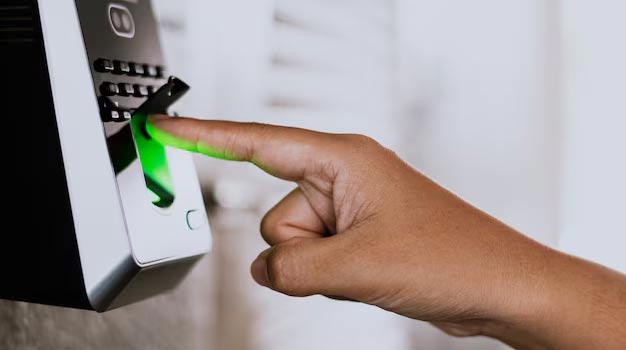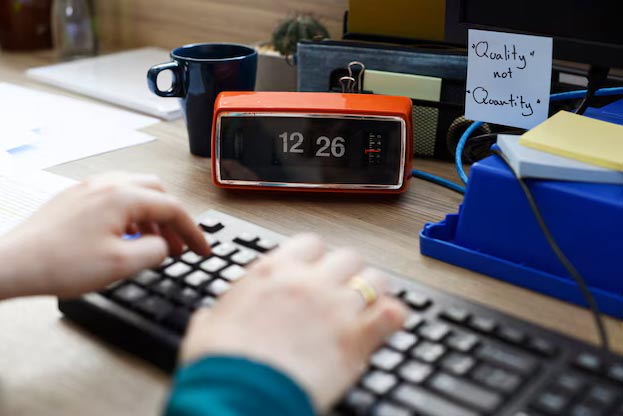Staff Time Management System: Tools, Monitoring, Techniques, And Softwares
Is your business losing money due to poor tracking of employee hours and project costs? Without clear visibility, your business is probably facing lost revenue and wasted resources. A staff time management system helps you take control, streamline operations, and boost productivity.
In this blog, we will explain what a staff time management system is, why it matters, and how it can transform the way you run your business.

Staff Time Management System
A staff time management system (STMS) is a digital tool designed to track employee hours, attendance, tasks, and schedules accurately. It records attendance, logs the time spent on tasks, and organises schedules. The main purpose is to give businesses a clear and accurate picture of staff work hours so they can plan better, avoid payroll mistakes, and improve overall efficiency.
This isn’t just for large companies. Today, freelancers, contractors, and agencies use staff time management software to log billable hours, manage multiple clients, and meet tight project deadlines with clarity and control.
What Is Time Tracking In A Time Management System?
Time tracking is the process of recording how long your team spends on work tasks
In a staff time management software, this can happen automatically (via timers or sensors) or manually (by logging time entries). Some popular methods include:
Web-based timers – Start/stop buttons built into software dashboards.
Mobile apps – Useful for remote or field-based staff.
Biometric scanners – Fingerprint or facial recognition at physical worksites.
Web clocks or kiosks – Common in offices or factories for shift logging.
Now, why does this matter? Because poor time tracking often leads to money leaks, missed billable hours, inaccurate payroll, and vague project estimates. Teams either overwork without being paid or underreport and cost the business money.
Accurate time tracking fixes that. It gives managers visibility into workloads, ensures fair pay, improves accountability, and keeps client billing on point.

How Are Time Management Systems Integrated With Hr And Payroll?
Staff management systems often sync directly with HR and payroll platforms through API connections or built-in modules. This syncing streamlines data such as clock-in/out times, breaks, leave records, and overtime, with payroll software, thus reducing labour efforts
Let’s say your company uses a biometric scanner for employee attendance, a staff time tracking app for task hours, and payroll software like eHRX. With integration in place:
As soon as an employee clocks in with a fingerprint, the attendance record is logged.
If they take a half-day or go on approved leave, the leave record gets synced with the HR module.
At the month’s end, total work hours, leaves, and overtime are automatically pulled into the system for salary processing.
The HR team does not have to spend the whole day collecting attendance sheets, calculating overtime, cross-checking leave records, and then forwarding all this data to payroll.
What Are The Benefits Of Using A Staff Time Management System?
We’ve seen how time tracking, when integrated with HR and payroll, removes a huge burden from teams like Priya’s. But the real impact goes beyond automation.
Here are four key benefits you’ll start noticing once you start using a staff time management system:
Higher Efficiency and Clearer Accountability
Manual tracking often leads to uneven workloads and missed deadlines. A staff time system shows:
How time is spent across tasks and projects
Which team members are overloaded or underutilised
Where bottlenecks are occurring in the workflow
Fewer Payroll Mistakes, Better Compliance
Linked time and payroll data reduce calculation errors. The system tracks hours, leave, and overtime automatically. This helps meet labour laws and avoid disputes. Records are stored and accessible when needed.
Enhanced remote and hybrid team management
Managing distributed teams can feel like a black box. You don’t always know what’s getting done or if it’s even aligned with priorities. A smart time management system adds visibility without micromanaging. You’ll know:
Which tasks are being worked on (and for how long)
How team members structure their day
If certain tools or workflows are slowing people down
For instance, if your developer spends two hours daily on bug fixes for a tool meant to speed things up, it might be time to reevaluate that software.
The result? Clearer expectations and smoother collaboration, even across time zones.
Time Savings for HR and Ops Team
A staff time management system cuts that time down drastically by automating:
Daily attendance tracking
Shift scheduling
Overtime approvals
Leave and holiday records
HR and ops can now redirect their time toward strategic work like hiring, training, improving culture, instead of chasing down timesheets and checking calculations.

How To Choose The Right Time Management System For Your Business?
Picking the right staff time management software is vital as it decides how comfortable your team is. The following factors will guide your decision:
1. Team Size and Work Type
Start by looking at how many people will use the system and what kind of work you do.
Small teams or freelancers only need basic task timers.
Larger businesses may want advanced features like project timelines or shift scheduling.
Industries with compliance
needs should
look for audit trails and
secure data handling.
2. Remote Work Support
If your team works remotely, go for
software that includes mobile access and
GPS
tracking. This ensures that time
is logged accurately, no matter where
the work happens.
3. Integration With Other Tools
Your staff time management software should easily connect with your current setup, such as payroll & HR tools, calendars, and messaging platforms. Integration helps reduce manual entry and keeps everything updated in one place.
4. Budget
Don’t overspend on features you won’t use.
Look for basic packages with upgrade options.
Match the tool’s value to what your team actually needs.
5. Ease of Use
Choose software that’s simple to set up and easy to use daily. A clean interface means fewer mistakes and better adoption. Also, check if they offer support or training when needed.
6. Room to Grow
Pick a system that can handle more users and extra features later. This way, you won’t need to switch tools as your team grows.
7. Try Before You Buy
Always take advantage of free trials or demos. This helps you test if the tool feels right for your workflow.
How Do Time Tracking Apps Prevent Time Theft And Buddy Punching?
Time theft occurs when
an employee gets paid for time they
didn’t
actually spend working. This
could include taking long breaks or
running personal errands while on the
clock.
Buddy punching is another
common form, where a colleague punches
in or out on someone’s behalf.
While it may seem like a harmless favour, but nearly 75% of businesses suffer payroll losses from buddy punching. That’s a massive dent in productivity and profits.
To prevent time theft, use modern staff time tracking apps that come with:
Facial recognition to confirm identity during clock-in/out.
GPS geofencing for location-based tracking
Biometric solutions like fingerprints or retina scans to mark attendance.
Access control to limit who can edit or approve time entries.

What’s The Difference Between Automatic And Manual Time Tracking?
Manual and automatic time tracking both help record work hours, but they differ in how time is captured and logged.
When you use spreadsheets (paper or digital) or time cards to record time logs for work done, it is called manual time tracking. For instance, you start a timer when you begin a task and stop it when you're done. If you forget, you can manually enter or adjust the time later.
On the other hand, in automatic time tracking, the software tracks your activity in the background, monitoring apps, websites, and files you are working on. Some tools also use AI to group tasks or suggest project tags.
Here is a side-by-side difference between automatic vs manual time tracking:
| Feature | Manual Tracking | Automatic Tracking |
| Accuracy | Depends on memory or discipline | High (tracks actual usage in real time) |
| Flexibility | High – great for irregular tasks or billable projects | Lower – may need editing or approval for categorisation |
| Ease of Use | Simple but requires action | Hands-off after initial setup |
| User Control | Full control over what's logged | Some users may feel monitored (even if private) |
| Best For | Freelancers, consultants, agencies | Developers, creatives, teams working on digital tools |
Are There Free Or Affordable Time Tracking Apps For Small Teams?
If you are a bootstrapped startup or a small business team, you can use the affordable time tracking tools:
| Tools | Free Plan Includes | Free for How Many Users | Limitations in Free Plan |
| Clockify | Time tracking, reports, manual entries, unlimited projects | Unlimited | Lacks advanced features like forecasting, audit logs |
| MyHours | Time tracking, project management, unlimited tasks, and scalability | 1 user | For solo use only |
| Harvest | Time tracking, invoicing, and expense tracking | 1 user, 2 projects | Only good for solo freelancers |
| Toggl Track | Real-time tracking, manual edits, basic reports | 5 users | Free tier doesn’t include billable rates or team management tools |
| TrackingTime | Task-based tracking, collaboration tools, project boards | 3 users | Limited reporting & integrations |
These apps keep small teams organised and accountable without demanding a big investment. Most offer a smooth upgrade path when your team grows or needs more features.
Frequently Asked Questions About Staff Time Management System
A staff time management system (STMS) allows you to monitor and track employee productivity by gathering data on their working hours in the office.
You can monitor employee working hours using time tracking software, biometric clocks, and GPS tracking systems.